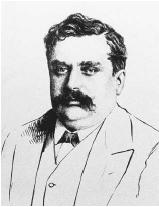Alfred Werner

FRENCH-BORN SWISS CHEMIST
1866–1919
Alfred Werner, the founder of coordination chemistry , was born on December 12, 1866, in Mulhouse, Alsace, France (in 1870 annexed to Germany). He was the fourth and last child of Jean-Adam Werner, a foundry worker and locksmith, and his second wife, Salomé Jeanette Tesché, the dominant figure in the Werner household and a member of the wealthy Tesché family. Although most of Werner's articles were published in the German language and in German journals, his cultural and political sympathies remained with France. The spirit of rebellion and resistance to authority that characterized his childhood and adolescence may have contributed to the development of his revolutionary coordination theory.
Werner attended the École Libre des Frères (1872–1878), and then the École Professionelle (1878–1885), a technical school where he studied chemistry. During his compulsory year of military service in the German army (1885–1886), he audited chemistry lectures at the Technische Hochschule (Technical University) in Karlsruhe. He then attended the Eidgenössisches Polytechnikum, now the Eidgenössische Technische Hochschule (Federal Polytechnic University), in Zurich, Switzerland, from which he received a degree in technical chemistry in 1889. He received his Ph.D. from the University of Zurich in 1890.
Between 1890 and 1893, Werner produced the three most important theoretical papers of his career. His doctoral dissertation (1890, cowritten with his teacher Arthur Hantzsch), a true classic of science writing on the topic of stereochemistry, extended Joseph Achille Le Bel and Jacobus Henricus van't Hoff's concept of the tetrahedral carbon compound (1874) to the nitrogen compound. It explained many puzzling paradoxes of geometrically isomeric, trivalent nitrogen compounds and placed nitrogen compound stereochemistry on a firm theoretical basis.
Werner's second theoretical paper (1891)—his Habilitationsschrift (an original article that was a requirement for teaching at a university)—took a stand against August Kekulé, the supreme architect of structural organic chemistry: It replaced Kekulé's focus on rigidly directed valences with a more flexible theory that viewed affinity as a somewhat cloudlike, attractive force emanating from the center of an atom and acting equally in all directions. During the winter of 1891–1892 Werner worked on thermochemical studies at the Collège de France in Paris with Marcellin Berthelot, but then returned to Zurich to become a privatdocent (unsalaried lecturer) at the Polytechnikum.
In 1893, at age twenty-six, Werner was appointed associate professor at the University of Zurich, largely owing to the almost overnight fame that resulted from his third article—the one that set forth his revolutionary, controversial coordination theory (which had occurred to him in a dream). Although his knowledge of inorganic chemistry was limited, he awoke at 2 A.M. with the solution of a long-standing puzzle centered on what were then called "molecular compounds." An enthralling lecturer and gifted researcher, he was promoted to full professor in 1895.
Werner discarded Kekulé's distinction between "valence" compounds, which are eminently explainable using classical valence theory, and "molecular compounds," which are not. Werner proposed a new approach in which the configurations of some compounds— metal -ammines (now sometimes called "Werner complexes"), double salts, and metal salt hydrates—were logical consequences of their coordination numbers (a new concept) and two types of valence, primary and secondary. For compounds having coordination number six he postulated an octahedral configuration; for those having coordination number four he proposed a square planar or tetrahedral configuration.
Werner's "ionogenic and nonionogenic" bonding concepts predated the currently used models of electrostatic and covalent bonding by a full generation. His ideas encompassed almost the entire field of inorganic chemistry and even found application in organic chemistry, analytical chemistry, and physical chemistry, as well as in biochemistry, geochemistry, and mineralogy. He was one of the first scientists to recognize that stereochemistry was not limited to organic chemistry, but is a general phenomenon. His coordination theory exercised an influence over inorganic chemistry comparable to that of the ideas of Kekulé, Archibald Scott Couper, Le Bel, and van't Hoff over organic chemistry.
Although today it is known that electronic configuration is the under-lying basis for chemical periodicity and the periodic system, Werner (in 1905), relying only on intuition, his vast knowledge of chemistry, and his recognition of analogies among elements, devised a "long form" of the Periodic Table, in which the lanthanide elements (inner transition elements or "rare earths" having atomic numbers 58 through 71), occupied a separate place in the table—a characteristic of all modern tables.
In 1913 Werner became the first Swiss chemist to win the Nobel Prize in chemistry, the prize given "in recognition of his work on the linkage of atoms in molecules, by which he has thrown fresh light on old problems and opened new fields of research, particularly in inorganic chemistry." Shortly thereafter, his health was declining. He died in a Zurich psychiatric hospital, on November 15, 1919. He was not only the founder of modern inorganic stereochemistry, but also one of the most brilliantly innovative chemists of all time.
SEE ALSO Coordination Compounds .
George B. Kauffman
Bibliography
Berl, E. (1942). "Some Personal Recollections of Alfred Werner." Journal of Chemical Education 19: 153–154.
Kauffman, George B. (1959). "Sophus Mads Jørgensen (1837–1914): A Chapter in Coordination Chemistry History." Journal of Chemical Education 36(10): 521–527.
Kauffman, George B. (1966). Alfred Werner: Founder of Coordination Chemistry. New York: Springer-Verlag.
Kauffman, George B. (1966). "Foundation of Nitrogen Stereochemistry." Journal of Chemical Education 43(3): 155–165.
Kauffman, George B. (1968). Classics in Coordination Chemistry, Part 1: The Selected Papers of Alfred Werner. New York: Dover Publications.
Morgan, G. T. (1920). "Alfred Werner." Journal of the Chemical Society (London) 117: 1,639–1,648.
Pfeiffer, Paul (1928). "Alfred Werner." Journal of Chemical Education 5: 1,090–1,098; reprinted in Great Chemists, ed. Eduard Farber. New York: Interscience Publishers (1961), pp. 1,233–1,243.
Read, John (1947). Humour and Humanism in Chemistry. London: G. Bell, pp. 262–284.
Comment about this article, ask questions, or add new information about this topic: